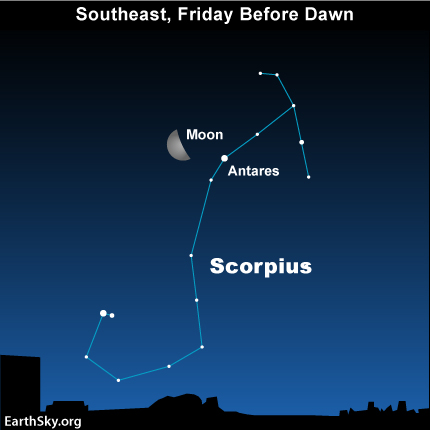Courtesy of EarthSky
A Clear Voice for Science
Visit EarthSky at
www.EarthSky.org [1]
 [2]
[2] [3]Friday morning – an hour or two before sunrise – the moon will shine quite close to the heart star of the constellation Scorpius. Find the rather fat waning crescent moon [4] in the south to southeastern sky. Then look for the nearby reddish star. If you can’t see the sanguine color of the Scorpion’s heart with the eye, try binoculars [5].
[3]Friday morning – an hour or two before sunrise – the moon will shine quite close to the heart star of the constellation Scorpius. Find the rather fat waning crescent moon [4] in the south to southeastern sky. Then look for the nearby reddish star. If you can’t see the sanguine color of the Scorpion’s heart with the eye, try binoculars [5].
That is Antares [6], the brightest star in Scorpius. This ruddy gem represents the Scorpion’s beating heart. Antares is not as red as a fire engine or a tomato. To me, it looks more like a faint ketchup-stain red. Antares is 16th brightest star in the night sky. A star this bright – and this close to the horizon – is bound to sparkle. Although you cannot see it, Antares has companion star, Antares B. This companion is blue in color. Can you imagine living on a planet that has a blue and a red sun?
Antares: Heart of the Scorpion [6]
Speaking of red, the moon may have an orange tinge when you see it near the horizon. That is because – at such times – you are looking through a greater thickness of atmosphere than when the moon is higher in the sky. The moon and Antares – the Scorpion’s heart – will rise in the southeast a few hours after midnight tonight, then will swing into the southern sky by daybreak on Friday, February 25.
Top tips for using ordinary binoculars for stargazing [8]
By EarthSky [9]
Astronomy Picture of the Day from NASA/JPL [10]
EarthSky: Space [11]
CHANDRA Photo Album [12]
U.S. Naval Observator Astronomical Information cente [13]r
Universe Today [14]
StarDate Online [15]
Sky and Telescope [16]
National Geographic [17]
Space Com [18]
Simostronomy Blog [19]
Amazing Space [20]
The York County Astronomical Society [21]
Scope City [22]